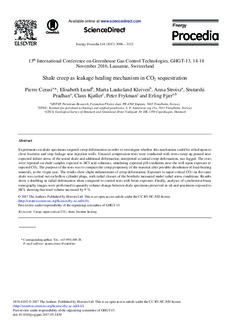| dc.contributor.author | Cerasi, Pierre | |
| dc.contributor.author | Lund, Elisabeth | |
| dc.contributor.author | Kleiven, Marta Laukeland | |
| dc.contributor.author | Stroisz, Anna Magdalena | |
| dc.contributor.author | Pradhan, Srutarshi | |
| dc.contributor.author | Kjøller, Claus | |
| dc.contributor.author | Frykman, Peter | |
| dc.contributor.author | Fjær, Erling | |
| dc.date.accessioned | 2017-12-15T15:32:41Z | |
| dc.date.available | 2017-12-15T15:32:41Z | |
| dc.date.created | 2017-08-21T11:05:52Z | |
| dc.date.issued | 2017 | |
| dc.identifier.citation | Energy Procedia. 2017, 114, 3096-3112. | nb_NO |
| dc.identifier.issn | 1876-6102 | |
| dc.identifier.uri | http://hdl.handle.net/11250/2472250 | |
| dc.description.abstract | Experiments on shale specimens targeted creep deformation in order to investigate whether this mechanism could be relied upon to close fractures and stop leakage near injection wells. Uniaxial compression tests were conducted with stress ramp up paused near expected failure stress of the tested shale and additional deformation, interpreted as initial creep deformation, was logged. The tests were repeated on shale samples exposed to HCl acid solutions, simulating expected pH conditions near the well upon exposure to injected CO2. The purpose of the tests was to compare the creep propensity of the material after possible dissolution of load-bearing minerals, to the virgin case. The results show slight enhancement of creep deformation. Exposure to super-critical CO2 on the same shale was carried out on hollow cylinder plugs, with radial closure of the borehole measured under radial stress conditions. Results show a doubling in radial deformation when compared to control tests with brine exposure. Finally, analyses of synchrotron beam tomography images were performed to quantify volume change between shale specimens preserved in oil and specimens exposed to HCl, showing that total volume increased by 9%. | nb_NO |
| dc.language.iso | eng | nb_NO |
| dc.publisher | Elsevier | nb_NO |
| dc.relation.uri | http://www.sciencedirect.com/science/article/pii/S1876610217316247 | |
| dc.rights | Attribution-NonCommercial-NoDerivatives 4.0 Internasjonal | * |
| dc.rights.uri | http://creativecommons.org/licenses/by-nc-nd/4.0/deed.no | * |
| dc.subject | Geomekanikk | nb_NO |
| dc.subject | Geomechanics | nb_NO |
| dc.title | Shale Creep as Leakage Healing Mechanism in CO2 Sequestration | nb_NO |
| dc.type | Journal article | nb_NO |
| dc.type | Peer reviewed | nb_NO |
| dc.description.version | publishedVersion | nb_NO |
| dc.subject.nsi | VDP::Andre geofag: 469 | nb_NO |
| dc.subject.nsi | VDP::Other geosciences: 469 | nb_NO |
| dc.source.pagenumber | 3096-3112 | nb_NO |
| dc.source.volume | 114 | nb_NO |
| dc.source.journal | Energy Procedia | nb_NO |
| dc.identifier.doi | 10.1016/j.egypro.2017.03.1439 | |
| dc.identifier.cristin | 1487583 | |
| dc.relation.project | Norges forskningsråd: 193816 | nb_NO |
| dc.description.localcode | © 2017 The Authors. Published by Elsevier Ltd. This is an open access article under the CC BY-NC-ND license https://creativecommons.org/licenses/by-nc-nd/4.0/ | nb_NO |
| cristin.unitcode | 194,64,90,0 | |
| cristin.unitname | Institutt for geovitenskap og petroleum | |
| cristin.ispublished | true | |
| cristin.fulltext | original | |
| cristin.qualitycode | 1 | |

